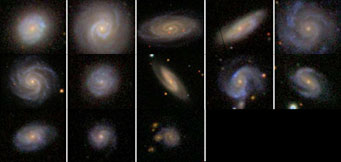Citizen scientists are helping astronomers understand how galaxies and their resident supermassive black holes grow.

Citizen scientists helped astronomers select these 12 face-on, bulgeless spiral galaxies. Each nucleus contains a healthy, growing supermassive black hole, despite the lack of a galactic bulge.
Sloan Digital Sky Survey / B. Simmons & others
In 2007 a simple online project invited the public to classify vast numbers of faint galaxies captured in beautiful panoramas by the Hubble Space Telescope. The trained human eye, astronomers judged, could still do a better job of assigning galaxies to their correct shape classifications than the best automated algorithms.
Five years later the Galaxy Zoo project is still going strong, but the classifications, still made by ordinary folks, have gotten more complex and ever more useful. Some 200,000 volunteers contributed to the collaboration’s most recent project. Its conclusion goes against the current paradigm of galaxy and black hole evolution.
Almost every galaxy contains a supermassive black hole at its center: a monster that can weigh a million to 10 billion Suns. A little while ago I wrote about new evidence showing that there’s more than one way to grow black holes this large. Astronomers used to think that galaxy collisions played a big role in black hole growth and galaxy evolution, but Galaxy Zoo’s newest result is the latest in a turning tide of evidence downplaying the importance of collisions.
Supermassive black holes are hosted by galaxies that have central bulges of old stars, and the two are tightly correlated — usually. For example, the Milky Way is home to a black hole weighing 4 million Suns, and as seen from the side, our galaxy would look a bit like a Frisbee with an elongated golf ball stuck in the center. The ball-like bulge of the Milky Way looks and behaves like an elliptical galaxy: its stars are old, the interstellar gas associated with them is long gone, and they travel in essentially random orbits giving the bulge its round, puffy shape.
The current theory is that early in a galaxy’s life, its central bulge and central black hole grow in lockstep with each other. Star formation and the black hole’s growth are both fed by infalling matter stirred up by collisions and mergers with other galaxies. Finally the black hole becomes so massive and active that gas blowing out from its surroundings clears out the galaxy’s entire inner region, halting both star formation and further feeding of the hole.
But do the black holes and bulges always need collisions to grow? Galaxy Zoo volunteers identified thousands of face-on spiral galaxies with no significant bulge. These bulgeless galaxies have probably never experienced a major collision with another galaxy. Out of 10,488 bulgeless galaxies, the Galaxy Zoo astronomers selected 12 that host healthy, growing black holes regardless, each with a mass of at least a million Suns.
If it’s really true that these galaxies have never collided with another, then the black holes must have grown entirely by other, less dramatic processes. They’re clearly a rarity, but they represent a “pure” sample, one that astronomers can study further to finally answer the question of all the ways that big black holes can grow.
 0
0
Comments
You must be logged in to post a comment.